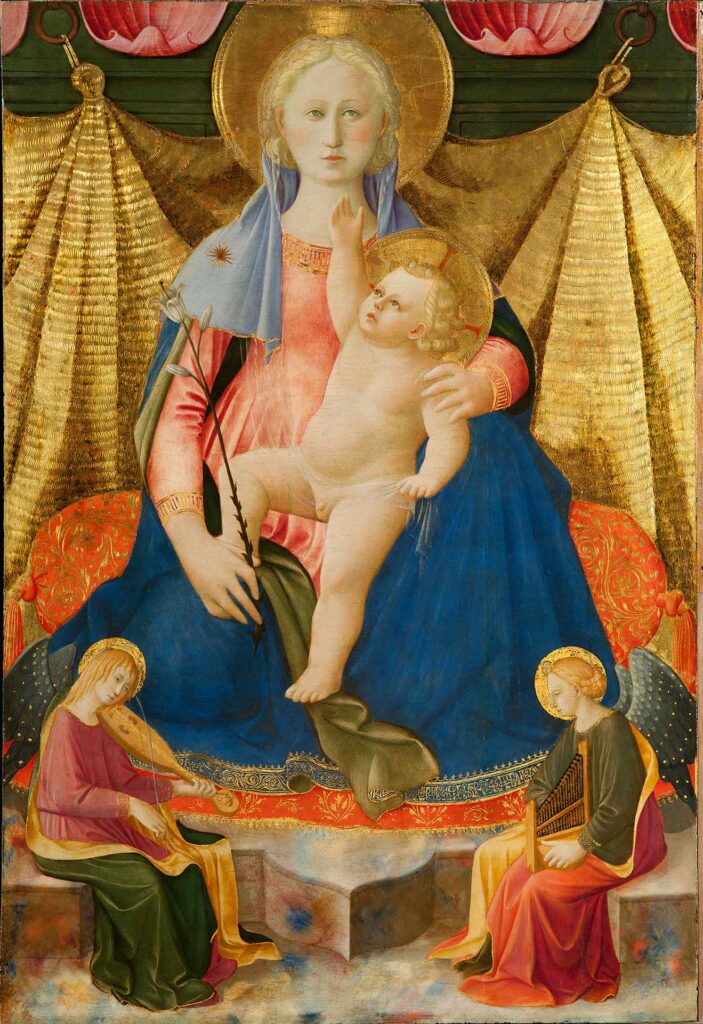Madonna of Humility with Musician Angels
Zanobi Strozzi , 1448 - 1450
Description

It is called Madonna of Humility the Virgin sitting on the ground, often on a cushion. In this work, Mary is sitting on a gold-embroidered red cushion, embellished with two tassels. She is wearing a red dress and a blue cloak with green edging; from her head falls a beautiful violet veil with a star: this attribute derives from “Stella Maris”, the Latin translation of the Hebrew name for Mary, Miriam. In one hand she holds a white lily, symbol of purity, while the other rests on the shoulder of the Child, who sits on her lap. Below, two musician angels are playing a viola da braccio (a type of viol held on the shoulder) and a portative organ, with absorbed and melancholy expressions.
A precious cloth hangs in the background, made with a gold leaf splendidly incised to imitate the softness of the fabric.
Zanobi Strozzi, who came from a wealthy Florentine family and was a close follower of Beato Angelico, worked as a painter as well as a manuscript illuminator. This Madonna, datable to between 1448 and 1450, is one of the best examples of the “paintings and panels” that Zanobi made “for the whole of Florence and the houses of its citizens”, as Giorgio Vasari wrote.
The work also shows the best qualities of Zanobi’s painting: the great care in the rendering of precious materials, like the cloth woven and embroidered in gold and the beautiful mottled marble of the base; a palette that also includes acid colours, like yellow and violet, as well as discordant colour contrasts, as the violet of the veil and the blue of the Virgin’s cloak.
Data Sheet
Author
Zanobi Strozzi, 1412-1468
Date
1448 - 1450
Material and technique
Tempera on panel
Measures
83.5 cm x 56.8 cm
Acquisition
Antonio and Bianca Leonardi De Feo, 2001
Inventory number
4744
location
Golden Room
The Golden Room is the most important room in the Museum and houses the masterpieces of painting from the Poldi Pezzoli collection. Conceived according to the dictates of the Renaissance style, it was designed to be the hall of honor of Gian Giacomo’s apartment. After the collector’s death, Giuseppe Bertini carried on the work: unfortunately, both the gilded coffered ceiling, the frescoes, painted by Bertini himself, and the damask fabric decorations that lined the walls were destroyed by bombing. The current museographic arrangement dates back to the 1990s. Among the works on display are the Portrait of a Lady attributed to Piero del Pollaiolo and which has become a symbol of the museum, Bellini’s Imago Pietatis, Botticelli’s Lamentation over the Dead Christ, Mantegna’s Madonna and Child, and Piero della Francesca’s Saint Nicholas of Tolentino. The display case separating the Salone Dorato from the Sala degli Stucchi houses the porcelain and majolica collections.
collection
Paintings
The Museum hosts over 300 paintings. Among them, many Italian works from the Renaissance: masterpieces from Tuscany (Botticelli, Piero della Francesca, Pollaiuolo), Lombardy (Luini, Boltraffio, Solario) and Veneto (Bellini, Mantegna). Important is also the group of 18th century Italian painting (Guardi, Canaletto, Tiepolo, Fra Galgario). In the collection, there are mainly portraits and small size paintings.
